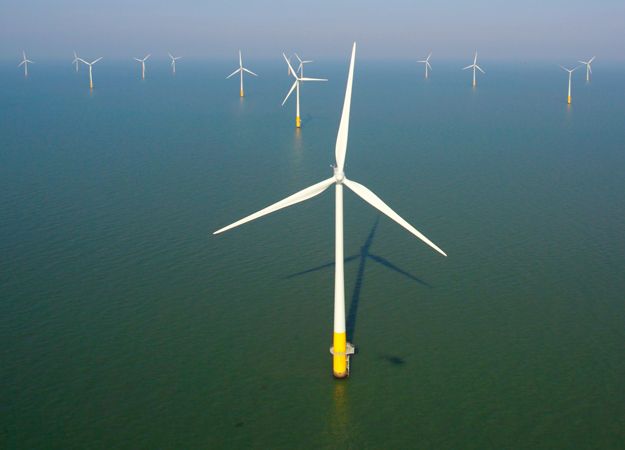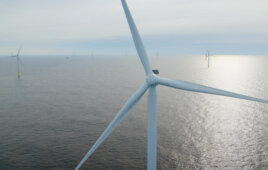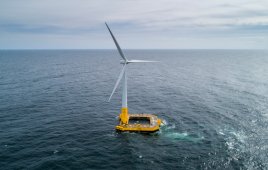Editor’s note: Genie81 made these comments in response to our early coverage of the Lake Erie Icebreaker offshore wind project. At the time, the project was in its infancy. Little information was available. Thanks to LeedCo VP of operations David Karpinski, a planner on the Icebreaker project, we are now better prepared to answer the posed questions. Some comments are rephrased for clarity.
Genie81: Will someone please tell me what is going to happen to sea life in our beautiful lakes? What materials will be used to construct the turbines? Do they still require backup 24/7 from some other source?
And when operating, will the noise echo cross the Lake, because sound seems to travel over water more so than other areas? Will people in pleasure craft be subjected to blade flicker, and will fishermen dodge thrown blades during winter?
Why are the developers continuing to destroy landscape, oceans, and waterways for non-green renewable energy?
There is much evidence that wind turbines are costly and inefficient, yet we are continually subjected to these industrial machines. Their technology has improved little and they are being built bigger, not better. The gravy train (gravy boat) keeps giving out taxpayer money while consumers continue to pay for rising electricity prices to the satisfaction of the wind industry.
In Wisconsin or Rhode Island, fixing a broken generator will cost the community between $220,000 and $1.5 million. The wind industry is not liable. Who is responsible when the turbines are no longer operational? Just go ahead and destroy Lake Erie for greed, not for clean energy.

A small portion of Lake Erie may someday look like this, but the initial plans call for just six turbines of this sort in the lake.
Editor Dvorak responds: Good news, Genie81: Your fears and concerns have been addressed by members of the Lake Erie Energy Development Co. Let me try to answer your questions based on recent project updates.
First, aquatic life will flourish around the offshore turbine foundations just as fish thrive around any natural or man-made reef. Sea life naturally congregate around underwater structures such as oil rigs and offshore wind turbine towers. The Brits say seals are more numerous around offshore structures because they are drawn by the lure of a fish dinner. It is probable that fish will view the wind-turbine foundations in Lake Erie as an appealing habitat.
As for material, the foundations will be made of solid American steel.
With regard to 24/7 backup: All power sources on the grid backup all others. That means the 18 MW of wind power planned for Lake Erie will provide backup for coal and nuclear plants when they must go offline. In fact, with the strong and steadier wind on the lake, it is quite likely that the power the turbines generate will be dispatchable.
What about noise and blade flicker? The turbines will be seven miles offshore so people on land won’t hear noise. Motorboats will be more noticeable. Similarly, blade flicker will not be a problem. Like most attractions, the wind farm will draw boaters, and tourists to the shore line. “Let’s go see the turbines,” will be a common refrain. And turbines are not known for throwing blades, so consider that a non-problem.
Yes, turbines come with a cost as does everything, but they also bring benefits. As for power prices, an onshore-turbine produces energy at an unsubsidized rate of about $0.065/kWh, about that of nuclear or coal generators. That figure is constantly inching lower. For comparison, my recent electric bill from AEP lists a power cost of $0.0819/kWh and an additional $0.0641/kWh for transmission giving a total rate of $0.145/kWh. The turbines selected for Icebreaker will be 3-MW units, not the biggest but manageable for this project.
You claim there has been “little improvement” in turbine technology, but just the opposite is true. The fifth generation turbines now leaving factories are the most reliable to date. And this factoid should please you: A recent DOE study cites the latest generation of turbines producing power at less than $0.03/kWh.
The government is funding some of the research with grant money, but there will be payback to local, state, and federal coffers once the jobs start.
I have no information on the broken generator you mentioned. But if it is a wind turbine generator, the wind-farm owner is responsible for it, not the community, unless it is a community wind farm.
When the Lake Erie wind farm nears retirement in about 2038 (if all goes to plan) the foundation could be removed because they are designed to be removed. More likely, foundations will be refitted with newer turbines having higher power ratings and lower production costs.
As you rightly acknowledge, the Great Lakes are a gift to the region. They are wonderful recreation areas and they allow the transportation of goods from the middle of American to the rest of the world. They are working waterways with the untapped resource of wind. To ignore their full potential is equivalent to buying power from countries that wish us nothing good.
–Paul Dvorak
Filed Under: Construction, Offshore wind, Towers




